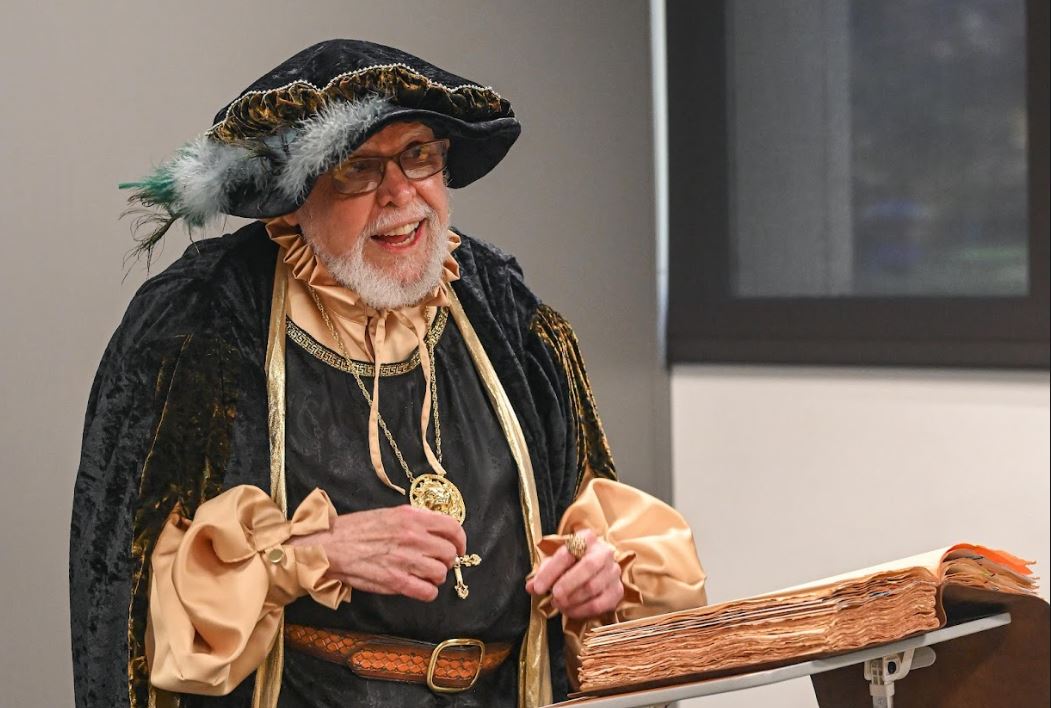Story by ADIA REYNOLDS Photos by RORY MOORE
Tiger Media Network
Retired history professor Robert Luehrs presented “The Unspeakable Horror of the Shapeshifter” on Halloween. Luehrs, a self-proclaimed “Halloween enthusiast,” even came dressed as a Renaissance specter.

Luehrs spoke to a full audience for his presentation on Halloween afternoon. More chairs were brought in to accommodate the unexpected boom of attendees, and even then, some still stood pressed against the back wall. He spoke about a well-themed topic to a well-dressed audience. Killer costumes were sprinkled amongst the audience as Luehrs discussed the history and cultural phenomena surrounding the myth of the shapeshifter.
“The Unspeakable Horror of the Shapeshifter” was a comedic and interactive experience. Luehrs’ assistant (dressed as ‘Anxiety’ from Inside Out 2) handed out boxes of limited edition Halloween cereal before presenting Luehrs with an ancient tome to read from.
“That’s right, I’m speaking on something that was unspeakable,” Luehrs began. “On the surface, we are polite, civilized. But what lies beneath the surface?”
Luehrs pointed out that shapeshifting is a universal trope that spans across global cultures and various timeframes. Dr. Jekyll and Mister Hyde. Ancient gods. Witches. And… the Incredible Hulk? Hello Kitty?
[“Despite these pop-culture examples], today what I want to emphasize, what I want to work with, is the werewolf,” Luehrs said. “Our view of the werewolf is that of a hybrid creature. Half human, half creature.”
Luehrs explained the myth of the werewolf began with the Greek myth of King Lycan, who attempted to serve the god Zeus human flesh. Zeus cursed Lycan and his fifty sons to become wolves. This is where the word ‘lycanthrope’ is derived from.
Then Luehrs migrated from Greece to Ireland, regaling the tale of The Three Daughters. For Samhain, the daughters would don wolfskin belts, kill livestock, and bring the fruits of their hunt back to their father. They were eventually tamed by flute song and the promise of a feast. But it was a trick. The music was a distraction. The daughters were killed by an army, and their spirits continued to dwell in the cave they called home.
Luehrs described the “seam of time” as the turning point between autumn and winter when the spiritual veil was thin. Halloween traditions of pumpkin carving, trick-or-treating, and dressing up are all vestigial habits that earlier cultures believed would protect them from spirits, ghouls, demons, and the like.
According to Luehrs, you might be a werewolf if:
- You have red hair
- The ring finger on your hand is the same length as your middle finger
- The backs of your hands are hairy
- You have a monobrow
- You love raw or rare meat
- You’re fascinated by death and gore
- You’re born with teeth
- You’re the seventh daughter or son
“One of the beauties of this myth is it continues to develop,” he said.


Most of the common presumptions surrounding werewolves were developed in the film “The Wolf Man” (1960). The aversion to silver, the curse being transmitted through a bite, and the full moon transformation are all products of the 20th century. One participant chimed in, adding, “nowadays it’s often silver crucifixes that work against werewolves.”
“Do you have silver bullets?” Another attendee taunted, to a general smattering of laughter.
Even up until the 1980s, werewolves were a prominent part of American culture. In 1988, the FOX channel opened a hotline for people to call in their werewolf sightings. 348,000 callers responded, claiming to have survived encounters or witnessed werewolves.
“When you’re out tonight celebrating Halloween, you tell me if that dog at the end of the street is truly just a dog,” Luehrs concluded to applause and even a howl or two.


You must be logged in to post a comment.